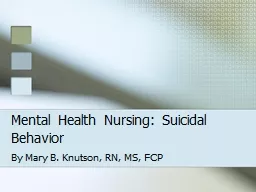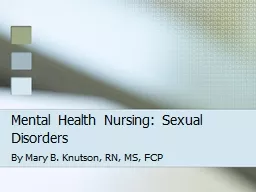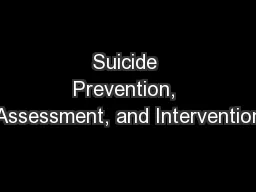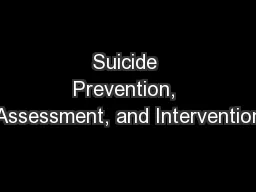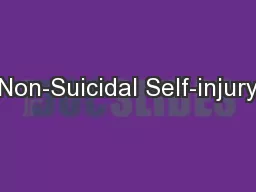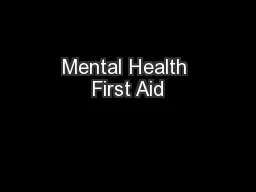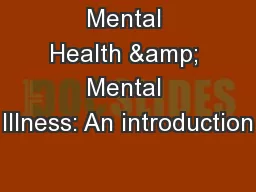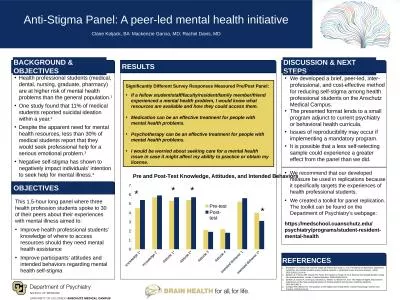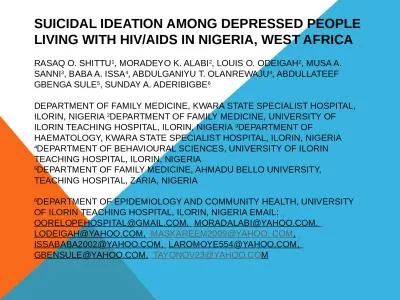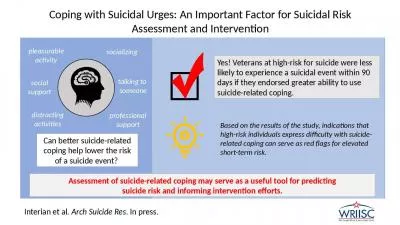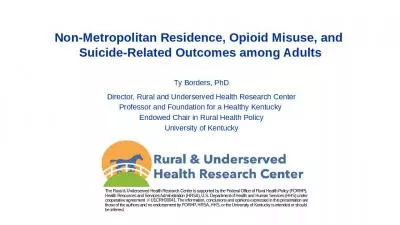PPT-Mental Health Nursing: Suicidal Behavior
Author : giovanna-bartolotta | Published Date : 2016-12-17
By Mary B Knutson RN MS FCP SelfProtective Responses Protection and survival are fundamental needs of all living things Life is characterized by risk Individuals
Presentation Embed Code
Download Presentation
Download Presentation The PPT/PDF document "Mental Health Nursing: Suicidal Behavior" is the property of its rightful owner. Permission is granted to download and print the materials on this website for personal, non-commercial use only, and to display it on your personal computer provided you do not modify the materials and that you retain all copyright notices contained in the materials. By downloading content from our website, you accept the terms of this agreement.
Mental Health Nursing: Suicidal Behavior: Transcript
By Mary B Knutson RN MS FCP SelfProtective Responses Protection and survival are fundamental needs of all living things Life is characterized by risk Individuals choose the amount of potential danger to expose themselves to. to Hope. A Recovery Lesson. Today we will explore how hopelessness affects us and our society.. This topic is important because having a successful recovery starts with hope. . Hopelessness can lead to overwhelming distress, self-harm, and suicidal thoughts - but it doesn’t have to.. By Mary B. Knutson, RN, MS, FCP. Definition of Sexuality. A desire for contact, warmth, tenderness, and love. Adaptive sexual behavior is consensual, free of force, performed in private, neither physically nor psychologically harmful, and mutually satisfying. The Role of a First Responder. Lisa Schwartz, LSW and Kathleen Kowalski, LCSW. Suicide Prevention Coordinators. Erie VAMC. 814-860-2038. Objectives. . 1. Identify the mental health, medical, and psychosocial factors that place individuals, especially Veterans, at risk for suicidal ideation and behavior. . The Role of a First Responder. Lisa Schwartz. , . LCSW. Suicide Prevention Coordinators. Erie VAMC. 814-860-2038. RISK FACTORS. High . gun . ownership -a major factor (guns are used in approximately 58% of completed suicides).. Legal and Ethical Concerns. Presented by. Amanda C. La Guardia, PhD, LPC-S, NCC. redshift80@gmail.com. Typical concerns. General Issues:. How can I tell the difference between NSSI and a suicide attempt?. Chair, Edwin S. . Shneidman. Program in . Thanatology. Marian University of Fond du Lac, WI. September, 2011. Shneidman. in a Nutshell:. Psychache. and Suicide . Learning Objectives. At the end of this presentation, the participant will be able to discuss: . Dr Tiff Earle, Consultant Psychiatrist – AWP. (Medical Lead for North Somerset & Chair MH Approvals Panel, South of England). – and –. Stephen Budd, North Somerset Involvement Co-ordinator - AWP. Elijah M . Marangu. Mental illness.. Or is it madness?. Mental illness.. Or is it madness?. Historical context. While . Philippe . Pinel. , a French Physician was . instrumental in . unchaining . people with mental illness, . March 13. th. , 2018. 2018 Oregon Suicide Prevention Conference. 5200 SW Macadam Portland OR 97239 . | . www.pdbti.org. Andrew White, PhD, Associate Director Portland DBT Institute. Topics for Today. population.. 1. . One study found that 11. % of medical students reported suicidal ideation within a . year. .. 2. . Despite the apparent need for mental health resources, less than 30% of medical students report that they would seek professional help for a serious emotional problem. . RasaQ. . O. Shittu. 1. , . Moradeyo. K. Alabi. 2. , Louis O. Odeigah. 2. , Musa A. Sanni. 3. , Baba A. Issa. 4. , . Abdulganiyu. T. Olanrewaju. 4. , . Abdullateef. . Gbenga. Sule. 5. , Sunday A. Aderibigbe. The International Association for Suicide Prevention (IASP) initiated World Suicide Prevention Day in 2003. The day is co-sponsored by the World Federation for Mental Health and World Health Organization. The aim of the day is to research and collect data on suicidal behavior, determine the various causes and why its signs go unnoticed, and developing sound practices and policies for suicide prevention. . Interian et al. . Arch Suicide Res. . In press.. Assessment of suicide-related coping may serve as a useful tool for predicting. suicide risk and informing intervention efforts.. Can better suicide-related coping help lower the risk of a suicide event? . Suicide-Related Outcomes among Adults. Ty Borders, PhD. Director, Rural and Underserved Health Research Center. Professor and Foundation for a Healthy Kentucky . Endowed Chair in Rural Health Policy.
Download Document
Here is the link to download the presentation.
"Mental Health Nursing: Suicidal Behavior"The content belongs to its owner. You may download and print it for personal use, without modification, and keep all copyright notices. By downloading, you agree to these terms.
Related Documents

